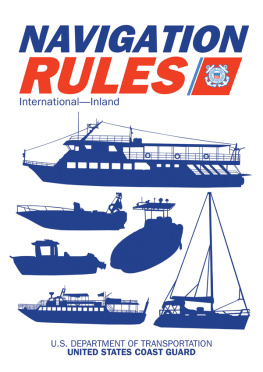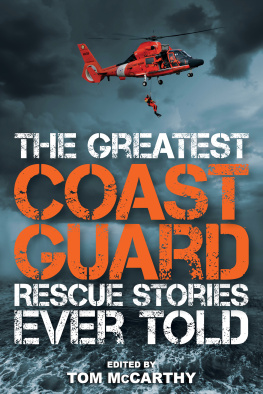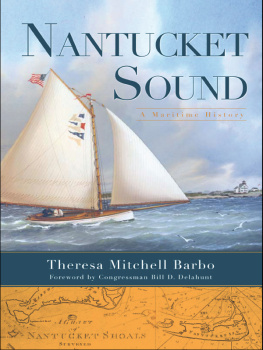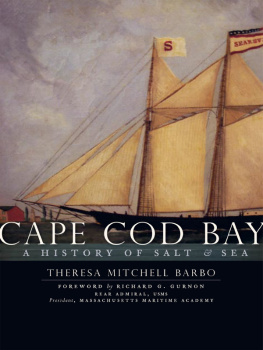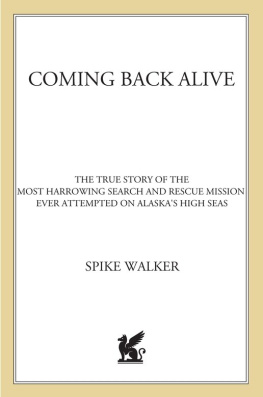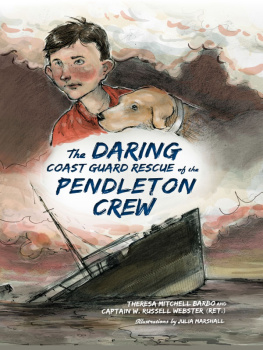On the Coast Guard Commandants Recommended Reading List for Leadership.
Theresa Barbo vividly recounts the heroic actions of the Pendleton rescue with insight from the heroes themselves, while paying tribute to the training and professionalism of the entire Coast Guard family.
Congressman William Delahunt, Tenth Congressional District, Massachusetts
A 36-foot motor lifeboat and its four-man crew were dispatched into the night and the storm from the Coast Guard Station at Chatham. As its coxswain, Bernard Webber recalled, they located the Pendleton in the dark only by this rumbling, crashing, banging sound over the wind and the sea. Maneuvering boldly, the Coast Guard lifeboat rescued 32 of the crew, a mission ably recounted by Theresa Mitchell Barbo of the Cape Cod Maritime Research Association.
Boston Globe
U PDATED T HIRD E DITION
T HE
P ENDLETON
D ISASTER
OFF C APE C OD
____________________________________
T HE G REATEST S MALL B OAT R ESCUE
IN C OAST G UARD H ISTORY
A True Story
T HERESA M ITCHELL B ARBO & C APTAIN W. R USSELL W EBSTER , USCG (R ET .)
F OREWORD BY A DMIRAL T HAD A LLEN (R ET .), CG36500 E SSAY BY M ASTER C HIEF J OHN J ACK D OWNEY (R ET .)
Published by The History Press
Charleston, SC 29403
www.historypress.net
Copyright 2010 by Theresa Mitchell Barbo and Captain W. Russell Webster, USCG
(Ret.)
All rights reserved
Front cover: On February 20, 1952, two days after a noreaster snapped the T2 tanker
Pendleton in two, Richard Kelsey photographed the hulk off Chatham, Cape Cod. CG
Station Chathams cook, Fred Wahrenburger, and another crewman look on.
Back cover: The 36500 Gold Medal crew outside Station Chatham in May 2002. Courtesy of Bernard C. Webber.
First published 2010
e-book edition 2011
ISBN 978.1.61423.020.5
Library of Congress Cataloging-in-Publication Data
Barbo, Theresa M.
The Pendleton disaster off Cape Cod : the greatest small boat rescue in Coast Guard
history / Theresa Mitchell Barbo and W. Russell Webster.
p. cm.
Includes bibliographical references and index.
print edition: ISBN 978-1-60949-050-8
1. Pendleton (Tanker)--History. 2. CG36500 (Lifeboat)--History. 3. Shipwrecks-
Massachusetts--Chatham--History. 4. Survival after airplane accidents, shipwrecks, etc.-
History. I. Webster, W. Russell. II. Title.
G530.P418B38 2010
910.916346--dc22
2010028293
Notice: The information in this book is true and complete to the best of our knowledge. It is offered without guarantee on the part of the author or The History Press. The authors and The History Press disclaim all liability in connection with the use of this book.
All rights reserved. No part of this book may be reproduced or transmitted in any form whatsoever without prior written permission from the publisher except in the case of brief quotations embodied in critical articles and reviews.
To my husband, Daniel, and our children, Katherine and Thomas: thank
you for your continued support, encouragement, love and good cheer!
To my wife, Elizabeth, who taught me to write and think like a reporter.
To my son Andrew and daughter Noelle, who inspire me with their talents,
energy and passion.
To our friend
In Memoriam
Bernard C. Webber
19282009
And to the memories of
Ervin Maske
19292003
Richard Livesey
19302007
C ONTENTS
F OREWORD
S mall boat operations are the DNA of the Coast Guard.
With only six years of service under his belt at the time of the 1952 rescue, the young boatswains mate, First Class Bernard C. Webber, Bernie as he was fondly known, orchestrated one of the greatest Coast Guard small boat rescues in Coast Guard history, earning the Gold Life Saving Medal for himself and his crew.
For the Guardians there was no turning back. Bernie had committed the lifesavers, deciding early on either they all would live or they all would die. Their odds of survival were nearly zero. These young men formed a team under emergency conditions and instinctively knew what to do. They trusted their lives unto each other. They were all in the same boat.
Bernie knew how to create the art of the possible where none existed.
In the fifty-eight years that have passed since this story has been told, men and women of the U.S. Coast Guard can still find relevance with their own dynamic missions of today in the actions of these fine men. Guardians have been known to self-activate untapped reserves of selfless devotion and instinct within themselves to do the right thing at the right time for the benefit of others, strangers in their midst trapped in extraordinary circumstances beyond their control.
The Coast Guards Capstone Doctrine explains our culture and principles of operation: clear objective, presence, unity of effort, on-scene initiative, flexibility, managed risk and restraint. These traits can be traced back to Alexander Hamiltons Letter of Instruction to the commanding officers of the first ten Revenue Marine cutters that continue to serve us today. They are reflected in the historic actions of leaders like Bernie Webber. This guidance along with the testimony within this book will help every member of the Coast Guardactive duty, reserve, civilian and auxiliaristunderstand who we are, what we do and why we do it.
The Capstone Doctrine maps our organizational DNA and reveals the evolution of our Guardian Ethos. It provides a solid foundation so we can adapt our operational activities to meet the maritime challenges of the twenty-first century. I encourage readers to reflect upon Bernies story as an example of a fundamental building block to educate and enhance their professional judgment in the face of mission demands.


